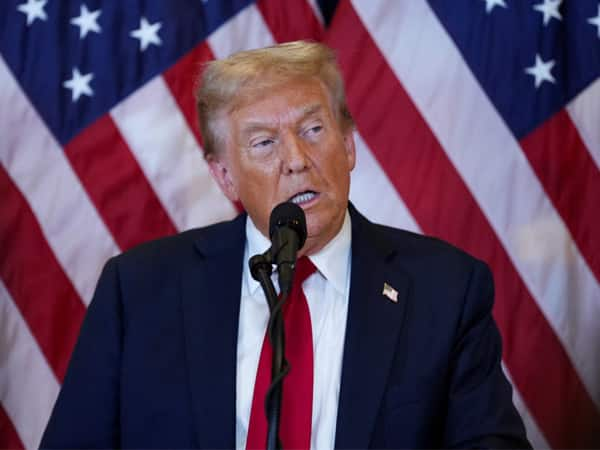US President Donald Trump has announced a sweeping set of reciprocal tariffs, claiming that foreign nations have "looted, pillaged, raped, and plundered" the American economy. Speaking on what he termed 'Liberation Day,' Trump detailed the tariffs, which include a 26% duty on Indian goods, 34% on Chinese imports, 20% on European Union products, 25% on South Korean items, 24% on Japanese exports, and 32% on Taiwanese merchandise.
"My fellow Americans, this is Liberation Day, a moment we have waited for a long time. April 2, 2025, will forever be remembered as the day American industry was reborn, the day America's destiny was reclaimed, and the day we began to Make America Wealthy Again," Trump said in his White House address. He also said that American taxpayers had been exploited for decades but vowed that such policies would no longer continue.
Trump's justification for tariffs:
Trump stressed that the United States had historically imposed lower tariffs compared to other nations. "The United States charges only a 2.4% tariff on motorcycles, while Thailand imposes 60%, India 70%, and Vietnam 75%. Similarly, America has long maintained a 2.5% tariff on foreign-made automobiles, whereas the European Union levies more than 10%, coupled with a 20% VAT. India, in particular, has been charging us 52%, while we have imposed almost nothing in return. This is going to change," Trump said.
The US President recounted his recent discussions with Indian Prime Minister Narendra Modi and said, "The Prime Minister just left—he's a great friend of mine—but I told him, 'You're not treating us right.'"
Full list of reciprocal tariffs:The newly announced tariffs will impact various nations as follows:
China: 34%
European Union: 20%
South Korea: 25%
India: 26%
Vietnam: 46%
Taiwan: 32%
Japan: 24%
Thailand: 36%
Switzerland: 31%
Indonesia: 32%
Malaysia: 24%
Cambodia: 49%
United Kingdom: 10%
South Africa: 30%
Brazil: 10%
Bangladesh: 37%
Singapore: 10%
Israel: 17%
Philippines: 17%
Chile: 10%
Australia: 10%
Pakistan: 29%
Turkey: 10%
Sri Lanka: 44%
Colombia: 10% Impact on India
India, which exported approximately $74 billion worth of goods to the US in 2024, could face significant economic challenges due to these tariffs. According to a Citi Research report, the move may result in annual losses of up to $7 billion. The most vulnerable sectors include chemicals, metal products, and jewellery, while pharmaceuticals, automobiles, and food products could also see substantial disruptions.
India's pharmaceutical exports, which account for 2.8% of total exports and 0.3% of GDP, are particularly at risk. A report from Morgan Stanley highlighted that petrochemicals, medical equipment, electrical components, and processed seafood—worth $2.58 billion in 2024—could also face major setbacks. Shrimp exports, for example, may see a sharp decline due to a tariff hike of nearly 28%.
However, some experts believe the overall impact of Trump's tariffs on India will be limited. According to SBI Research, the potential decline in Indian exports to the US would be around 3% to 3.5%, assuming tariffs remain in the 15-20% range. Global financial firms such as Goldman Sachs, Nomura, and Fitch argue that India's diversified export strategy and emphasis on value addition will help mitigate the negative effects.
India's response and future strategy:India is already preparing for negotiations with the US, aiming to finalise the first phase of a trade agreement by September-October 2025. Both nations have set a target to increase bilateral trade from $190 billion to $500 billion by 2030.
The Indian government is evaluating strategies to counterbalance US tariffs, including trade diversification, enhancing export incentives, and securing new supply chain routes. India has also launched an initiative to document non-tariff barriers faced by its exporters in the US, with a dedicated online platform set to be introduced within two months.
Additionally, India is considering offering trade concessions on certain US imports, such as premium medical devices, pork, and luxury motorcycles. Increased purchases of American defense equipment, aircraft, oil and gas, and technology products are also on the table. Moreover, India is positioning itself as a viable alternative to China in sectors like semiconductors, electronics, and renewable energy by offering tax incentives and easier land access in states like Gujarat, Tamil Nadu, and Andhra Pradesh.
Global economic outlook:Despite these trade tensions, global economists remain optimistic about India's growth trajectory. The International Monetary Fund (IMF) predicts that India will continue to be the world's fastest-growing economy, soon becoming the third-largest globally.
You may also like

JPC chief slams Owaisi for tearing Waqf Bill in Lok Sabha

'Manipulation And Fraud': BIG Blow To West Bengal Government As SC Upholds Calcutta HC's Decision To Cancel Over 25k School Staff Appointments

UK weather maps show when 22C mini-heatwave will hit in April

Tornado emergency declared as deadly storm tears through Arkansas and Midwest

'It was a historic day': BJP MP Dinesh Sharma after Lok Sabha clears Waqf Amendment Bill







